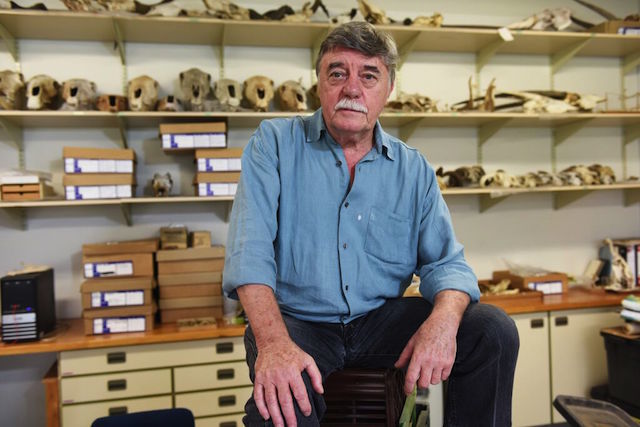John Parkington: living landscapes and local heritage
22 December 2015 | Story Natalie Simon. Photo Michael Hammond.
Clanwilliam, a small town nestled between the slopes of the Cederberg mountains and the Olifants River in the Western Cape, is home to an archeological treasure trove of rock art, fossils, natural features and ruined structures, which offer clues into the lives of the San hunter-gatherers who lived in that region thousands of years ago.
When Professor John Parkington, emeritus professor in the Department of Archeology, began his work in this region back in the 1960s, the present-day residents of Clanwilliam, a small and impoverished population, had no insight into the wealth of history that lay beneath their feet.
“In the 1990s, a strong sense had begun to develop among archeologists that we should dedicate more time and effort to communicating knowledge back into the communities from which it originally comes,” says Parkington. And so, in the mid-1990s, Parkington launched the Living Landscapes Project in which the research being conducted in Clanwilliam became entrenched into the local community. The project aims, firstly, to raise awareness of the rich archeological history of the region in the schools. Parkington and his colleagues have spent nearly 20 years teaching Clanwilliam’s children to understand how people lived in that region tens of thousands of years ago.
“In one project we took all the town’s grade seven pupils down to the banks of the Olifants River three times a month for five months,” says Parkington. “We showed them that the stones lying around were actually artifacts. We showed them why we believed some of these artifacts were a million years old, and some only a few thousand years old. “For the children, the fact that it is real research they are participating in is very exciting,” he says.
The second part of the project aims to boost the economy and employment levels in Clanwilliam through heritage tourism. The project offers training to the local community, both in the form of practical skills, such as computing skills, first aid and entrepreneurship, as well as skills that allow community members to benefit from the rich history of the region. Through the centre, a number of Clanwilliam locals were trained as rock art guides, craftspeople, caterers and as custodians of the local heritage.
“I believe over the years it has been running, the Living Landscapes Project has raised around R12 million for projects in the community,” says Parkington. "But we have also, in one way or another, had an impact on around 3 000 schoolchildren and offered training to several hundred adults. “If you look around Clanwilliam today,” he says, “I do believe we have made a difference.”
When Professor John Parkington, emeritus professor in the Department of Archeology, began his work in this region back in the 1960s, the present-day residents of Clanwilliam, a small and impoverished population, had no insight into the wealth of history that lay beneath their feet.
“In the 1990s, a strong sense had begun to develop among archeologists that we should dedicate more time and effort to communicating knowledge back into the communities from which it originally comes,” says Parkington. And so, in the mid-1990s, Parkington launched the Living Landscapes Project in which the research being conducted in Clanwilliam became entrenched into the local community. The project aims, firstly, to raise awareness of the rich archeological history of the region in the schools. Parkington and his colleagues have spent nearly 20 years teaching Clanwilliam’s children to understand how people lived in that region tens of thousands of years ago.
“In one project we took all the town’s grade seven pupils down to the banks of the Olifants River three times a month for five months,” says Parkington. “We showed them that the stones lying around were actually artifacts. We showed them why we believed some of these artifacts were a million years old, and some only a few thousand years old. “For the children, the fact that it is real research they are participating in is very exciting,” he says.
The second part of the project aims to boost the economy and employment levels in Clanwilliam through heritage tourism. The project offers training to the local community, both in the form of practical skills, such as computing skills, first aid and entrepreneurship, as well as skills that allow community members to benefit from the rich history of the region. Through the centre, a number of Clanwilliam locals were trained as rock art guides, craftspeople, caterers and as custodians of the local heritage.
“I believe over the years it has been running, the Living Landscapes Project has raised around R12 million for projects in the community,” says Parkington. "But we have also, in one way or another, had an impact on around 3 000 schoolchildren and offered training to several hundred adults. “If you look around Clanwilliam today,” he says, “I do believe we have made a difference.”
 This work is licensed under a Creative Commons Attribution-NoDerivatives 4.0 International License.
This work is licensed under a Creative Commons Attribution-NoDerivatives 4.0 International License.
Please view the republishing articles page for more information.










